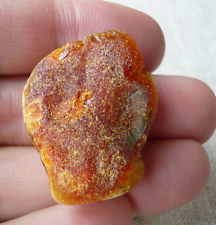This is the gemstone that is not a stone at all.
Amber is not really a gemstone. It is the fossilized resin from ancient fir trees. This is actually apparent if you heat it a little bit, you will smell pine. Just imagine walking through a pine forest and rubbing the tree bark, your hands get very sticky with wet resin. That is what amber is..
The origin of Amber goes back millions of years. Amber resin is from trees, that went solid then became fossilized… over many, many thousands of years. Around 45 million years ago, pine trees in the Baltic regions, the Scandinavian countries… discharged resins. The resin eventually found it’s way to the oceans where it fossilized. Then much later it was brought to the surface by glaciers and deposited on the land, where it has been found since that time.
Amber amulets and talismans have been found in stone age excavations, it has been loved for centuries because of it’s color and calming influence.
Amber occurs in a range of different colors. As well as the usual yellow-orange-brown that is associated with the color “amber”, amber itself can range from a whitish color through a pale lemon yellow, to brown and almost black. Other uncommon colors include red amber (sometimes known as “cherry amber”), green amber, and even blue amber, which is rare and highly sought after.
The oldest amber found is over 125 million years old and was discovered in Lebanon.This type of amber has become known as Jurassic amber.
Quite often insects have been found embedded in amber. In August 2012, two mites preserved in amber were determined to be the oldest animals ever to have been found in the substance; the mites are 230 million years old and were discovered in north-eastern Italy.
Amber jewelry has been worn for centuries and was once only worn by nobility,as it was not affordable for the masses. When being made into modern jewelery, amber is heated to deepen color and add “sun spangles”
It is used in teething rings and has a great calming influence producing a positive effect on the heart, kidneys and nervous system.
Baltic amber, usually the best quality is not used for teething rings but when worn against your skin warming with body heat will reduce pain. that is because it contains succinic acid, a natural analgesic and healing agent.
It is also thought to bring good luck.. You can even wear your amber in the swimming pool.
The problem with amber it is very easy to fake. So be aware of what you are buying. One way to test the authenticity of your amber is to drop it into some water. Real amber floats, plastic does not, although these days I am sure modern imitations will probabaly float. Not too helpful.
Here is also a note from “www.greencrafts.com”
“Natural amber for jewelry is never cut to a regular shape – it is only tumbled and polished on surface. These tumbled pieces are called “chips” and have various irregular shapes. Holes may be drilled in them to create a necklace. Any amber piece with a regular, unnatural, geometric shape is a pressed piece.
Pressed amber commonly exhibits the so called “sun spangles” or “fish scales” – round fissures that are residues of trapped water or air bubbles which have collapsed under pressure at elevated temperature. Natural amber can exhibit also some fissure-like imperfections, but there are much less and they are less “glistening”. ”
*** Sources: Wikipedia, mindat.org, “Colored Gemstones” by Antoinette Matlins, and greencrafts.com

